Related Research Articles
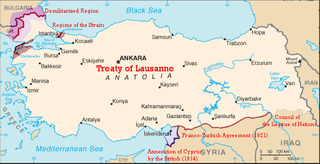
The Treaty of Lausanne was a peace treaty negotiated during the Lausanne Conference of 1922–23 and signed in the Palais de Rumine, Lausanne, Switzerland, on 24 July 1923. The treaty officially settled the conflict that had originally existed between the Ottoman Empire and the Allied French Republic, British Empire, Kingdom of Italy, Empire of Japan, Kingdom of Greece, and the Kingdom of Romania since the onset of World War I. The original text of the treaty is in French. It was the result of a second attempt at peace after the failed and unratified Treaty of Sèvres, which aimed to divide Ottoman lands. The earlier treaty had been signed in 1920, but later rejected by the Turkish national movement who fought against its terms. As a result of Greco-Turkish War, İzmir was retrieved and Armistice of Mudanya was signed in October 1922. It provided for the Greek-Turkish population exchange and allowed unrestricted civilian passage through the Turkish Straits.

The Treaty of Sèvres was a 1920 treaty signed between the Allies of World War I and the Ottoman Empire. The treaty ceded large parts of Ottoman territory to France, the United Kingdom, Greece and Italy, as well as creating large occupation zones within the Ottoman Empire. It was one of a series of treaties that the Central Powers signed with the Allied Powers after their defeat in World War I. Hostilities had already ended with the Armistice of Mudros.

The Greco-Turkish War of 1919–1922 was fought between Greece and the Turkish National Movement during the partitioning of the Ottoman Empire in the aftermath of World War I, between May 1919 and October 1922.

The Turkish War of Independence was a series of military campaigns waged by the Turkish National Movement after parts of the Ottoman Empire were occupied and partitioned following its defeat in World War I. The campaigns were directed against Greece in the west, Armenia in the east, France in the south, monarchists and separatists in various cities, and Britain and Italy in Constantinople. Simultaneously, the Turkish nationalist movement carried out massacres and deportations in order to eliminate native Christian populations—a continuation of the Armenian genocide and other ethnic cleansing operations during World War I. These campaigns resulted in the creation of the Republic of Turkey.
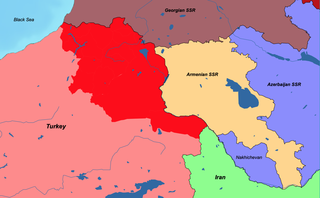
The Treaty of Kars was a treaty that established the borders between Turkey and the three Transcaucasian republics of the Soviet Union, which are now the independent republics of Armenia, Georgia and Azerbaijan. The treaty was signed in the city of Kars on 13 October 1921.

The Turkish–Armenian war, known in Turkey as the Eastern Front of the Turkish War of Independence, was a conflict between the First Republic of Armenia and the Turkish National Movement following the collapse of the Treaty of Sèvres in 1920. After the provisional government of Ahmet Tevfik Pasha failed to win support for ratification of the treaty, remnants of the Ottoman Army’s XV Corps under the command of Kâzım Karabekir attacked Armenian forces controlling the area surrounding Kars, eventually recapturing most of the territory in the South Caucasus that had been part of the Ottoman Empire prior to the Russo-Turkish War (1877–1878) and was subsequently ceded by Soviet Russia as part of the Treaty of Brest-Litovsk.
The Conference of London was a conference convened in order to deal with the problems resulting from the peace treaties that ended World War I, most notably the Treaty of Sèvres with the Ottoman Empire, which was militarily opposed by the Turkish National Movement.
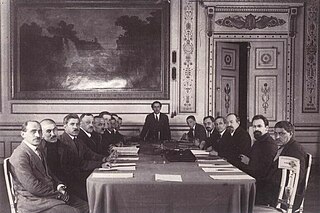
The Treaty of Moscow, or Treaty of Brotherhood was an agreement between the Grand National Assembly of Turkey (TBMM), under the leadership of Mustafa Kemal, and Russia, under the leadership of Vladimir Lenin, signed on 16 March 1921. Neither the Republic of Turkey nor the Soviet Union had then been established. The internationally recognised Turkish government at the time was that of Sultan Mehmed VI, but it was not party to the Treaty of Moscow. The Sultan's government had signed the Treaty of Sèvres, which had been repudiated by the Turkish National Movement.
The Battle of Alexandropol was a conflict between the First Republic of Armenia and Turkish Revolutionaries of the Turkish National Movement which was on November 7, 1920 at Alexandropol.

Wilsonian Armenia refers to the unimplemented boundary configuration of the First Republic of Armenia in the Treaty of Sèvres, as drawn by U.S. President Woodrow Wilson's Department of State. The Treaty of Sèvres was a peace treaty that had been drafted and signed between the Western Allied Powers and the defeated government of the Ottoman Empire in August 1920, but it was never ratified and was subsequently superseded by the Treaty of Lausanne. The proposed boundaries of Wilsonian Armenia incorporated portions of the Ottoman vilayets of Erzurum, Bitlis, Van, and Trabzon, which had Armenian populations of varying sizes. The inclusion of portions of Trabzon Vilayet was intended to provide the First Republic of Armenia with an outlet to the Black Sea at the port of Trabzon. A proposed Republic of Pontus was discussed at the Paris Peace Conference of 1919, but the Greek government of Eleftherios Venizelos feared the precarious position of such a state, so a portion of it was instead included in the proposed state of Wilsonian Armenia.
The Treaty of Alexandropol was a peace treaty between the First Republic of Armenia and the Grand National Assembly of Turkey. The treaty ended the Turkish-Armenian War that had begun on 12 September 1920, with the Turkish invasion of former-Ottoman lands ceded to Armenia in the Treaty of Sevres, a month prior.

The Franco–Turkish War, known as the Cilicia Campaign in France and as the Southern Front of the Turkish War of Independence in Turkey, was a series of conflicts fought between France and the Turkish National Forces from December 1918 to October 1921 in the aftermath of World War I. French interest in the region stemmed from the Sykes-Picot Agreement, and was further fueled by the refugee crisis following the Armenian genocide.
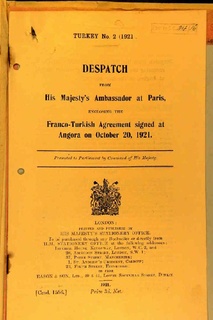
The Ankara Agreement (1921) was signed on 20 October 1921 at Ankara between France and the Grand National Assembly of Turkey, ending the Franco-Turkish War.

The partition of the Ottoman Empire was a geopolitical event that occurred after World War I and the occupation of Constantinople by British, French and Italian troops in November 1918. The partitioning was planned in several agreements made by the Allied Powers early in the course of World War I, notably the Sykes-Picot Agreement, after the Ottoman Empire had joined the Ottoman–German Alliance. The huge conglomeration of territories and peoples that formerly comprised the Ottoman Empire was divided into several new states. The Ottoman Empire had been the leading Islamic state in geopolitical, cultural and ideological terms. The partitioning of the Ottoman Empire after the war led to the domination of the Middle East by Western powers such as Britain and France, and saw the creation of the modern Arab world and the Republic of Turkey. Resistance to the influence of these powers came from the Turkish National Movement but did not become widespread in the other post-Ottoman states until the period of rapid decolonization after World War II.

The Red Army invasion of Georgia, also known as the Soviet–Georgian War or the Soviet invasion of Georgia, was a military campaign by the Russian Red Army aimed at overthrowing the Social-Democratic (Menshevik) government of the Democratic Republic of Georgia (DRG) and installing a Bolshevik regime in the country. The conflict was a result of expansionist policy by the Russians, who aimed to control as much as possible of the lands which had been part of the former Russian Empire until the turbulent events of the First World War, as well as the revolutionary efforts of mostly Russian-based Georgian Bolsheviks, who did not have sufficient support in their native country to seize power without external intervention.

Russia–Turkey relations is the bilateral relationship between Russia and Turkey and their antecedent states. Relations between the two are rather cyclical. From the late 16th until the early 20th centuries, relations between the Ottoman and Russian empires were normally adverse and hostile and the two powers were engaged in numerous Russo-Turkish wars, comprising one of the longest wars in modern history. Russia attempted to extend its influence in the Balkans and gain control of the Bosphorus at the expense of the weakening Ottoman Empire. As a result, the diplomatic history between the two powers was extremely bitter and acrimonious up to World War I. However, in the early 1920s, as a result of the Bolshevik Russian government's assistance to Turkish revolutionaries during the Turkish War of Independence, the governments' relations warmed. Relations again turned sour at the end of WWII as the Soviet government laid territorial claims and demanded other concessions from Turkey. Turkey joined NATO in 1952 and placed itself within the Western alliance against the Warsaw Pact during the Cold War, when relations between the two countries were at their lowest level. Relations began to improve the following year, when the Soviet Union renounced its territorial claims after the death of Stalin.

Soviet Union–Turkey relations were the diplomatic relations between the Soviet Union and the Republic of Turkey.

The Azerbaijan–Turkey border is a short 17 km (11 mi) long international border between the Republic of Azerbaijan and the Republic of Turkey. The border is located at the southeastern tip of the Iğdır Province on the Turkish side and at the northwestern tip of the Nakhchivan Autonomous Republic on the Azerbaijani side; running entirely along the Aras river, it is the shortest border for both countries.
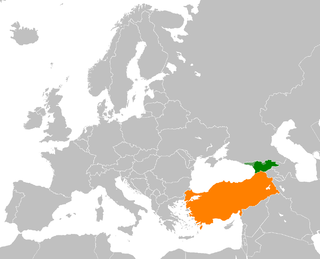
The Georgia–Turkey border is 273 km in length and runs from the Black Sea coast in the west to the tripoint with Armenia in the east.

The Armenia–Turkey border is 311 km in length and runs from the tripoint with Georgia in the north to the tripoint with Azerbaijan in the south.
References
- ↑ "League of Nations - Chronology 1921". Archived from the original on 2010-12-13. Retrieved 2008-11-08.